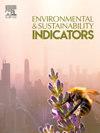Development of an integrated indicator for assessing management impacts on soil quality: A case study in organic viticulture
IF 5.4
Q1 ENVIRONMENTAL SCIENCES
引用次数: 0
Abstract
Given that soil is an invaluable resource for viticulture, it is important to maintain its properties in order to keep it healthy and optimize ecosystem processes underpinning productivity. Although measuring sustainability poses challenges, it remains crucial for developing specific management strategies designed for a given geographic area. This study introduces the Management Impact on Soil Quality (MISQ), an integrated indicator designed to assess how common management practices influence the attributes of soil health in organic vineyards. The MISQ evaluates five key management components: soil disturbance, regeneration of soil organic matter, terrestrial eco-toxicity impact of copper, efficiency of nutrient (NPK) use, and biodiversity. This indicator was applied using data collected from an organically-managed vineyard in Franciacorta, a grape-producing area in Northern Italy over the years 2014, 2015, 2019 and 2021. The results indicate how enhanced soil function depends on increased supply of organic matter and diversified cover cropping with legumes, thereby improving soil biodiversity. However, managing potential nutrient surplus and recognizing the risks associated with tillage for row spacing management are also crucial factors. These results provide viticulturists with a valuable tool for assessing the effects of agronomic techniques on soil quality, thereby facilitating sustainable management practices. This study highlights the need to preserve the soil multifunctionality, which is critical for nutrient cycling, soil structural stability and biological population control. The straightforward approach of the MISQ makes it suitable for use in different environments, thereby promoting effective management strategies that mitigate a negative impact on soil functionality.
评估管理对土壤质量影响的综合指标的发展:以有机葡萄栽培为例
鉴于土壤是葡萄栽培的宝贵资源,保持其特性以保持其健康并优化支撑生产力的生态系统过程非常重要。虽然衡量可持续性带来了挑战,但它对于制定针对特定地理区域的具体管理战略仍然至关重要。本研究引入了管理对土壤质量的影响(MISQ),这是一个综合指标,旨在评估常见管理措施对有机葡萄园土壤健康属性的影响。MISQ评估了五个关键管理组成部分:土壤干扰、土壤有机质的再生、铜的陆地生态毒性影响、养分(NPK)利用效率和生物多样性。该指标采用了2014年、2015年、2019年和2021年从意大利北部葡萄产区弗朗西亚科尔塔(Franciacorta)的一个有机管理葡萄园收集的数据。结果表明,土壤功能的增强取决于有机质供应的增加和豆类覆盖种植的多样化,从而改善土壤生物多样性。然而,管理潜在的营养过剩和认识到行距管理与耕作相关的风险也是至关重要的因素。这些结果为葡萄种植者提供了评估农艺技术对土壤质量影响的宝贵工具,从而促进可持续管理实践。该研究强调了保持土壤多功能性的必要性,这对养分循环、土壤结构稳定和生物种群控制至关重要。MISQ的直接方法使其适用于不同的环境,从而促进有效的管理策略,减轻对土壤功能的负面影响。
本文章由计算机程序翻译,如有差异,请以英文原文为准。
求助全文
约1分钟内获得全文
求助全文
来源期刊

Environmental and Sustainability Indicators
Environmental Science-Environmental Science (miscellaneous)
CiteScore
7.80
自引率
2.30%
发文量
49
审稿时长
57 days
 求助内容:
求助内容: 应助结果提醒方式:
应助结果提醒方式:


